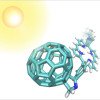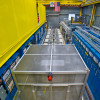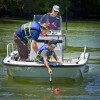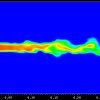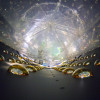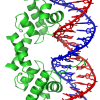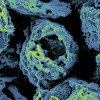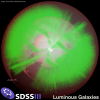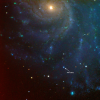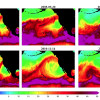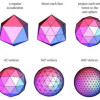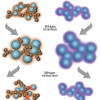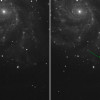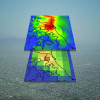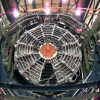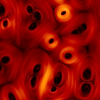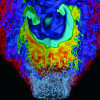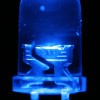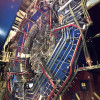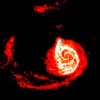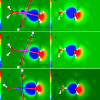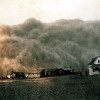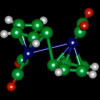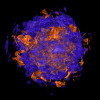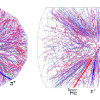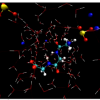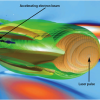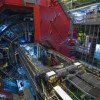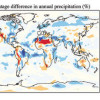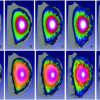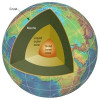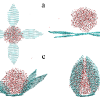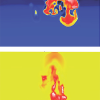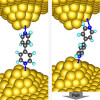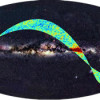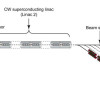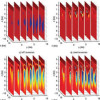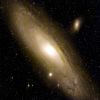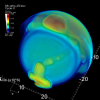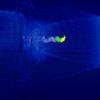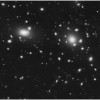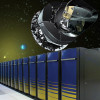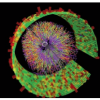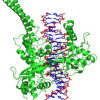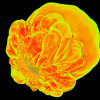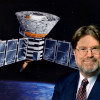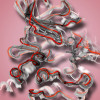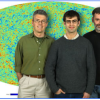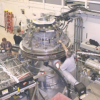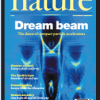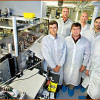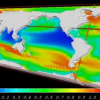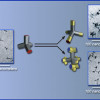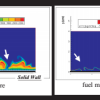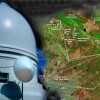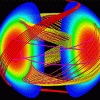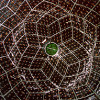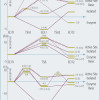Science News
Learning From Photosynthesis to Create Electricity
Inspired by plants, scientists have created a light-harvesting material that can turn sunlight into chemical energy. However, creating a stable form of the material for large-scale usage has proved difficult. Read More »
New Accelerator Will Study Steps on the Path to Fusion Power
The Neutralized Drift Compression Experiment, NDCX-II has recently marked successful completion. Designed with the aid of computer simulations executed at NERSC, the accelerator was created to study warm dense matter, an important research field in itself and particularly relevant to nuclear fusion. NDCX-II will test a variety of technologies in preparation for a new generation of power plants on Earth that will mimic the engines of the stars. Read More »
Floating Robots Track Water Flow, Stream Data via Smartphones
To understand how water flows through the Sacramento-San Joaquin Delta, 100 mobile sensors were placed into the Sacramento River on May 9 to make critical measurements every few seconds. Once collected, this data is transmitted to NERSC for assimilation and analysis. Read More »
New Computer Codes Unlock the Secrets of Cleaner Burning Coal
Researchers supported by the Department of Energy are investigating relatively "clean" methods for extracting energy from coal—like gasification. Using NERSC systems, a scientist from the University of Utah has developed tools to model and validate the complex processes of coal gasification Read More »
Researchers Discover a New Kind of Neutrino Transformation
Some unprecedentedly precise measurements from the Daya Bay Neutrino Experiment are revealing how electron antineutrinos “oscillate” into different flavors as they travel. This finding may eventually solve the riddle of why there is far more ordinary matter than antimatter in the universe today. Read More »
A Roadmap for Engineering Piezoelectricity in Graphene
With the help of supercomputers at the Department of Energy’s NERSC, researchers at Stanford University have uncovered yet another hidden talent of graphene—with a little chemical doping, it can be transformed into a controllable piezoelectric material. This discovery could lead to a wide variety of nanoscale devices from electronics and photonics to chemical sensing and high frequency acoustics. Read More »
New Mathematical Method Reveals Where Genes Switch On or Off
Developmental biologists using computing resources at NERSC, have taken a new mathematical method used in signal processing and applied it to biochemistry, using it to reveal the atomic-level details of protein–DNA interactions with unprecedented accuracy. They hope this method, called “compressed sensing,” will speed up research into where genes are turned on and off, and they expect it to have applications in many other scientific domains as well. Read More »
Bubbles Help Break Energy Storage Record for Lithium Air-Batteries
Using supercomputers at NERSC and microscopy, a team of researchers from the Pacific Northwest National Laboratory and Princeton University recently built a novel graphene membrane that could produce a lithium-air batter with the highest-energy capacity to date. Read More »
The Great Gas Hydrate Escape
For some time, researchers have explored flammable ice for low-carbon or alternative fuel or as a place to store carbon dioxide. Now, a computer analysis of the ice and gas compound, known as a gas hydrate, reveals key details of its structure. This work could enlighten alternative fuel production and carbon dioxide storage. Read More »
Calculating What’s in the Universe from the Biggest Color 3-D Map
Using NERSC systems, Berkeley Lab scientists and their Sloan Digital Sky Survey colleagues have produced the biggest 3D color map of the universe ever. The team also achieved the most accurate calculation yet of how matter clumps together – from a time when the universe was only half its present age until now. Read More »
Closest Type Ia Supernova in Decades Solves a Cosmic Mystery
Even as the "supernova of a generation" came into view in backyards across the northern hemisphere last August, physicists and astronomers who had caught its earliest moments were developing a surprising and much clearer picture of what happens during a titanic Type Ia explosion. Now they have announced the closest, most detailed look ever at one of the universe’s brightest “standard candles,” the celestial mileposts that led to the discovery of dark energy. Read More »
A Better Way to ID Extreme Weather Events in Climate Models
A team of researchers that includes Berkeley Lab scientists are using state-of-the-art methods in data mining and high-performance computing to quantify extreme weather phenomena in the very large datasets generated by today’s climate models. Their work will help scientists predict how climate change impact the frequency of extreme weather events. Read More »
Supercomputers Take a Cue From Microwave Ovens
To build the break-through supercomputers that climate researchers need to model clouds, scientists are taking a cue from consumer electronics where everything from chips to batteries to software is optimized to the device’s application. Read More »
Turning Grass into Gas for Less
Recent computer simulations carried out at the National Energy Research Scientific Computing Center (NERSC) could help scientists in their quest to make biofuels from grasses and other inedible plants. Read More »
A Better Lithium-ion Battery on the Way
Lithium-ion batteries are everywhere, in smart phones, laptops, an array of other consumer electronics, and the newest electric cars. Good as they are, they could be much better, especially when it comes to lowering the cost and extending the range of electric cars. To do that, batteries need to store a lot more energy. A team of scientists at the U.S. Department of Energy’s Lawrence Berkeley National Laboratory (Berkeley Lab) has designed a new kind of anode — a critical… Read More »
Supernova Caught in the Act
A supernova discovered yesterday is closer to Earth—approximately 21 million light-years away—than any other of its kind in a generation. Astronomers believe they caught the supernova within hours of its explosion, a rare feat made possible by a specialized survey telescope and state-of-the-art computational tools.The discovery of such a supernova so early and so close has energized the astronomical community as they are scrambling to observe it with as many telescopes as possible,… Read More »
Small Particles, Big Impact
High-resolution simulation for Mexico City (top), shows a more detailed and accurate picture of aerosol pollution compared to representations of a global climate model (bottom). The deep red to light green colors represent concentrations of aerosol pollution with red being highest, light green lowest. Using systems at the National Energy Research Scientific Computing Center (NERSC), atmospheric scientists at the Pacific Northwest National Laboratory (PNNL) have found that small scale effects of… Read More »
Magellan Tackles Mysterious Proton Spin
The STAR experiment's detector records the decay of subatomic smash-ups to uncover how the fundamental building blocks of the universe work. What makes a proton spin? That is one of the biggest mysteries in physics. Although researchers do not fully understand the underlying physics of this phenomenon, they do know that it contributes to the stability of the universe, magnetic interactions, and are a vital component of technologies like Magnetic Resonance Imaging (MRI) machines that are used… Read More »
At Solar System's Edge, There be...Bubbles?
This animated computer simulation shows how magnetic bubbles form at the edge of our solar system. It was created on NERSC's "Franklin" supercomputer using 8,192 processor cores simultaneously running for 20 hours. (Credit: James F. Drake) NASA's Voyager probes have reached the end of our solar system where they've found neither giants nor dragons, but something nearly as surprising—a turbulent froth of magnetic bubbles. Using new computer models to analyze Voyager data, scientists computing… Read More »
Petaflops Power to NERSC
The National Energy Research Scientific Computing Center (NERSC) recently marked a major milestone, putting its first petascale supercomputer into the hands of its 4,000 scientific users. The flagship Cray XE6 system is called “Hopper” in honor of American computer scientist Grace Murray Hopper; it is capable of more than one quadrillion floating point operations per second, or one petaflops, and is currently the second most powerful supercomputer in the United States, according to the TOP500 list. Read More »
NERSC Systems Help Develop Next-Generation Combustion Equipment
Robert Cheng demonstrates his low swirl burner in the lab. The housing remains cool to the touch, as shown here. Combustion – the complex chemical process of burning fuels – is a huge driver behind the American economy and standard of living, producing more than 83 percent of our nation’s energy. In addition to fueling power plants, combustion also drives aircraft, ships, locomotives, and trucks and cars (even hybrids). At home, we rely on combustion for heating systems, water heaters,… Read More »
Proton Dripping Tests a Basic Force of Nature
Despite its prevalence in nature, researchers are still searching for the precise laws that govern the strong force--the essential "glue" that holds atomic nuclei together to form atoms. However, the recent discovery of an extremely exotic, short-lived nucleus called fluorine-14 in laboratory experiments may indicate that scientists are gaining a better grasp of these rules.
Read More »
LED Lighting Comes out of the Dark
New findings from simulations carried out at the National Energy Research Scientific Computing Center (NERSC) have unearthed the cause of a problem that limits the use of ultra-efficient, light-emitting diodes in general lighting, researchers say. Read More »
Heaviest Antimatter Particle Detected with NERSC Help
Eighteen examples of the heaviest antiparticle ever found, the nucleus of antihelium-4, have been made in the STAR experiment at RHIC, the Relativistic Heavy Ion Collider at the U.S. Department of Energy’s Brookhaven National Laboratory. The finding wasn’t unexpected, but it is a milestone for scientists exploring a fundamental puzzle of physics: Why is there any matter at all? Read More »
Boosting the Next Wave of Accelerators
Generating computer models of 'tabletop accelerators' has proven difficult, slow, and costly. To solve this problem, a team of scientists computing at the National Energy Research Scientific Computing Center (NERSC) has perfected a new method that generates models anywhere from 10,000 to a million times faster than before.
Read More »
Cyclones Linked to Pliocene Warming
Scientists searching for clues to Earth’s future climate are turning to its dim past, the Pliocene epoch. Using computer simulations, researchers are unraveling a mystery that has bedeviled climatologists for years: Why was the Pliocene – under conditions similar to today – so much hotter? Recent work suggests that tropical cyclones (also called hurricanes or typhoons) may have played a crucial role. Read More »
'Dark' Milky Way Satellite Galaxy Uncovered
Sukanya Chakrabarti has developed a mathematical method uncover “dark” satellite galaxies. When she applied this method to our own Milky Way, Chakrabarti discovered a faint satellite might be lurking on the opposite side of the galaxy from Earth, approximately 300,000 light-years from the galactic center. Read More »
Modeling the Bonds of Iron and Water
Using supercomputers at the Department of Energy's National Energy Research Scientific Computing Center (NERSC), scientists have successfully modeled the atomic interactions between a high spin ferric iron ion and 64 water molecules for the first time. Researchers say this unprecedentedly accurate model will offer valuable insights into key reactions involved in carbon sequestration and other environmental remediation projects. Read More »
A Goldilocks Catalyst
Carbon dioxide (CO2) emissions from fossil fuel combustion are major contributors to global warming. Since CO2 comes from fuel, why can't we recycle it back into fuel rather than releasing it into the atmosphere? Read More »
Clearer Picture of Carbon Sequestration
Berkeley Lab scientists are using computer simulations run at NERSC to help evaluate one method for keeping carbon dioxide emitted by fossil fueled power plants out of the atmosphere: Geologic sequestration in salty water reservoirs deep underground. Researchers have created the most detailed models yet of the mixing processes that occur at the interface of sequestered carbon dioxide (CO 2) and brine in geologic sequestration projects.These simulations—including the first three-dimensional ones—will help scientists better predict the success of this kind of project. Read More »
Climate Time-Machine
An international team of climatologists have created a comprehensive reanalysis of all global weather events from 1871 to the present day with help from NERSC. Over the last four years, the project's leader, Gil Compo, has put to use over 20 million processing hours at NERSC to help make it happen. Read More »
Rechargeable Heat Battery's Secret Revealed
Researchers computing at NERSC have shown that a fulvalene diruthenium molecule undergoes a structural transformation when it absorbs sunlight, putting the molecule into a higher-energy or charged state where it can remain stable indefinitely. Then, triggered by a small addition of heat or a catalyst, it snaps back to its original shape, releasing heat in the process. Read More »
Berkeley and Princeton Scientists Watch Stars Explode in 3D
Researchers from Princeton University and the Lawrence Berkeley National Laboratory have found a new way to make computer simulations of supernovae exploding in three dimensions. The new simulations are based on the idea that the collapsing star itself is not sphere-like, but distinctly asymmetrical and affected by a host of instabilities in the volatile mix surrounding its core. Read More »
NERSC Helps Shed Light on the Nature of Antimatter
Using the National Energy Research Scientific Computing Center's (NERSC) Parallel Distributed Systems Facility (PDSF) and the Brookhaven National Laboratory’s Relativistic Heavy Ion Collider (RHIC), physicists have detected and confirmed the first-ever antimatter hypernucleus, called "antihypertriton." Translated, the newly detected "antihypertriton" means a nucleus of antihydrogen containing one antiproton and one antineutron—plus one heavy relative of the antineutron, an antilambda hyperon. Most of the objects in the cosmos today consists of matter, comprised of "normal" particles like positively charged protons and negatively charged electrons. Read More »
Dancing in the Dark
Berkeley Lab scientists have applied x-ray absorption spectroscopy to study a model protein, triglycine – a short chain of three molecules of the simplest amino acid, glycine. By simulating this molecule’s x-ray absorption spectrum the team has show how its chain kinks and straightens in response to ions in solution. Read More »
Taking the 'Large' out of Large Hadron Collider
Particle accelerators like the Large Hadron Collider (LHC) at CERN are the big rock stars of high-energy physics—really big. The LHC cost nearly USD$10 billion to build and its largest particle racetrack (27 km in circumference) stretches across a national border. However, a recent breakthrough in computer modeling may help hasten the day when accelerators thousands of times more powerful can be built in a fraction of the space—and for significantly less money. Read More »
California Is the Primary U.S. Stop for LHC's ALICE Data
For approximately one month a year, the nuclei of lead atoms traveling near the speed of light will collide in the Large Hadron Collider's (LHC) ALICE experiment, generating a fireball about 100,000 times hotter than the core of our Sun. At these temperatures protons and neutrons dissolve into a "particle soup" of quarks and gluons, known as the quark-gluon plasma—a state of matter that first occurred in nature at the birth of our Universe almost 14 billion years ago, a few millionths of a second after the Big Bang. By watching this "soup" cool, physicists hope to better understand the nature of matter, which makes up everything from galaxies to humans. Read More »
Simulations Show That "Sweaty" Flowers Cool the World
The world is a cooler, wetter place because of transpiring flowers, say University of Chicago researchers who ran more than a million lines of code on the National Energy Research Scientific Computing Center's (NERSC's) IBM Power5 "Bassi" system last year. They found that this effect is especially pronounced in the Amazon basin, where 80 percent of ever-wet rainforest area would not exist without flowering plants. These findings were published online on June 16, 2010 in Proceedings of the Royal Society B. Read More »
Computing Enables New Insights into Generating Power Like the Sun
If humans could harness nuclear fusion, the process that powers stars like our sun, the world could have an inexhaustible energy source. But researchers still do not understand the behavior of plasmas well enough to effectively confine them to generate a sustainable flow of energy. NERSC simulations show that that instabilities at the plasma edge can can cause multiple pulses of instability, which damage plasma containment chambers. Read More »
Simulations Reveal Earth's Silica Is Predominantly Superficial
Silica is one of the most common minerals on Earth. Not only does it make up two-thirds of our planet's crust, it is also used to create a variety of materials from glass to ceramics, computer chips and fiber optic cables. Yet new quantum mechanics results generated by a team of physicists computing at the National Energy Research Scientific Computing Center (NERSC) show that this mineral only populates our planet superficially—in other words, silica is relatively uncommon deep within the Earth. Read More »
Bringing Clouds into Focus
David Randall, principal investigator for the "Global Cloud Modeling" project that computes at NERSC, is working to clear up uncertainty in global climate models caused by differing methods of accounting for the effects of clouds. He is developing and testing a new kind of global climate model, called a global cloud resolving model (GCRM)—a model that's designed to take advantage of the extreme-scale computers expected in the near future. Read More »
Brace for Impact
While the fireworks at CERN's Large Hadron Collider (LHC) transfix the world, theorists are quietly doing some computational heavy lifting to help understand what these particle smash-ups might reveal about the fundamental mystery of existence: Why is there anything at all? The Standard Model of particle physics can't explain why there exists more matter than antimatter in the universe. At the LHC and other colliders, scientists sift the debris of high-energy particle collisions searching for clues to physics that lie beyond our current understanding. Read More »
NERSC Users Find That Nanodroplets of Water Can Manipulate Graphene
Chemists from the University of Illinois at Chicago using the National Energy Research Scientific Computing Center's (NERSC) Cray XT4 supercomputer, called Franklin have found that nanodroplets of water can be used to shape graphene into complex capsules, sandwiches, knots, and rings to serve as the building blocks of nanodevices with unique mechanical, electrical, and optical properties. Read More »
NERSC Helps Locate Jupiter's Missing Neon
It's raining helium on Jupiter—and as these droplets fall towards the planet's deeper interior, they are bringing neon down with them. This new result, published in the March 26 issue of Physical Review Letters, solves a 15-year-old mystery that was initiated on December 7, 1995, when NASA's Galileo probe plunged into Jupiter's atmosphere and found only one-ninth the amount of neon that should have been there based on measurements of the Sun's composition. The authors, Burkhard Militzer and Hugh Wilson of the University of California, Berkeley, were able to answer this decade-old question with some supercomputing help from the Department of Energy's National Energy Research Scientific Computing Center (NERSC). Read More »
Baby Brutes
Astronomers have in recent years been surprised to find hulking brutes among the baby galaxies of the early Universe. Studded with bright, giant clumps of rapidly forming stars, these big galaxies hail from a time when the cosmos was less than 4 billion years old, yet each contains about the mass of a modern Milky Way, which took 10 billion years to form. Once considered oddities, these galaxies are now thought to be the engines that drove the Universe's most active period of star formation. It remains a mystery, however, how such massive galaxies came to be so quickly and what has happened to them in our modern Universe. Read More »
A Computational Science Approach for Analyzing Culture
Just as photography revolutionized the study of art by allowing millions of people all over the world to scrutinize sculptures and paintings outside of museums, researchers from the Software Studies Initiative at the University of California at San Diego (UCSD) believe that a new paradigm called cultural analytics will drastically change the study of culture by allowing people to quantify evolving trends across time and countries. Read More »
Mismatched alloys are a good match for thermoelectrics
Employing some of the world’s most powerful supercomputers, scientists at Lawrence Berkeley National Laboratory have shown that mismatched alloys are a good match for the future development of high performance thermoelectric devices. Read More »
NERSC Helps Researchers Discover a Potential On-Off Switch for Nanoelectronics
Researchers at the Lawrence Berkeley National Laboratory's (Berkeley Lab) Molecular Foundry and Columbia University found that electrical resistance through a molecular junction—a nanometer scale circuit element consisting of a single molecule contacted with gold wires—can be turned on and off by simply pushing and pulling the junction. Experts believe that this newly demonstrated molecular-scale control could be leveraged for future nanoscale electronic devices. Read More »
NERSC Continues Tradition of Cosmic Microwave Background Data Analysis with the Planck Cluster
More than 95 percent of our universe is made up of mysteriously "dark" materials—approximately 22 percent of it is comprised of invisible dark matter, while another 73 percent is posited to be dark energy, the force that is accelerating universal expansion. Armed with a new spacecraft called Planck and supercomputers at the Department of Energy's (DOE) National Energy Research Scientific Computing Center (NERSC), astronomers around the world hope to make tremendous strides toward illuminating the nature and origins of these mystifying materials by creating high-resolution maps of extremely subtle variations in the temperature and polarization of the Cosmic Microwave Background (CMB), which is leftover light from the Big Bang that permeates the universe. Read More »
It's Not Too Late to Change Global Warming's Course
The threat of global warming can still be greatly diminished if nations cut emissions of heat-trapping greenhouse gases by 70 percent this century, according to a study led by scientists at the National Center for Atmospheric Research (NCAR). While global temperatures would rise, the most dangerous potential aspects of climate change, including massive losses of Arctic sea ice and permafrost and significant sea level rise, could be partially avoided. Read More »
Lasers without Mirrors, Designed by Supercomputer
Sometimes it takes a big machine to understand the tiniest details. That’s the case with free electron lasers (FELs). FELs have the potential to address a host of research challenges in physics, chemistry and material and biological sciences. Read More »
NERSC Contributes to EMGeo Mapping Software for Finding Hidden Oil and Gas Reserves
As the world's demand for energy increases, billions of dollars are dedicated to the search for deep-water hydrocarbon reservoirs each year. Although seismic imaging methods have long been used to collect valuable information on geological structures bearing hydrocarbon deposits, they have not proven effective in discriminating different types of reservoir fluids, such as brines, oil, and gas. Because of this inability to discriminate, over time huge financial losses result from drilling dry holes—up to 100 million dollars per each unsuccessful drilling. Meanwhile significant hydrocarbon reservoirs remain undiscovered. Read More »
NERSC Helps Discover Cosmic Transients
An innovative new sky survey, called the Palomar Transient Factory (PTF), will utilize the unique tools and services offered by the Department of Energy's (DOE) National Energy Research Scientific Computing Center (NERSC) at the Lawrence Berkeley National Lab (Berkeley Lab) to expose relatively rare and fleeting cosmic events, like supernovae and gamma ray bursts. Read More »
Visualizing the Future of Scientific Discovery
As computational scientists are confronted with increasingly massive datasets from supercomputing simulations and experiments, one of the biggest challenges is having the right tools to gain scientific insight from the data.A team of Department of Energy (DOE) researchers recently ran a series of experiments to determine whether VisIt, a leading scientific visualization application, is up to the challenge. Running on some of the world's most powerful supercomputers, VisIt achieved unprecedented… Read More »
NERSC and CRD Help Decipher Science from Compact Accelerator Simulations
Scientists use many different tools to understand the universe. While telescopes offer valuable insights about interactions between stars, planets and galaxies; particle accelerators give researchers a better understanding of the basic particles that make up these structures, as well as the fields and forces that hold them together. The bigger the accelerator, the more energy subatomic particles can pick up, which leads to higher-intensity impacts that expose ever more basic particles, fields and forces. However, bigger is also costlier, and scientists worry that accelerators built with today's technology may simply be unaffordable. Read More »
Deep Sky Project Provides a Portal into Data Universe
Every night approximately 3,000 astronomical files flow to the National Energy Research Scientific Computing (NERSC) Center from automated sky scanning systems all over the world for archiving. After a decade of collecting, the center currently holds over 8 million images, making this one of the largest troves of ground-based celestial images available. Now, a multidisciplinary team of astronomers, computer scientists, and engineers from NERSC are collaborating to develop a user-friendly database system and interface to instantly serve up high-resolution cosmic reference images to astronomers around the globe. Read More »
Humanities and High Performance Computers Connect at NERSC
High performance computing and the humanities are finally connecting — with a little matchmaking help from the Department of Energy (DOE) and the National Endowment for the Humanities (NEH). Both organizations have teamed up to create the Humanities High Performance Computing Program, a one-of-a-kind initiative that gives humanities researchers access to some of the world’s most powerful supercomputers. Read More »
A Rising Tide of Cosmic Data
In 1998 the balloon-borne BOOMERANG and MAXIMA experiments made what were then the highest-resolution measurements of minute variations in the temperature of the cosmic microwave background radiation (CMB). Their high resolution was achieved by scanning small patches of the sky to gather unprecedented volumes of data. The analysis of these datasets presented a significant computational challenge – they were the first CMB datasets to require supercomputing resources. Read More »
IMPACTS: On the Threshold of Abrupt Climate Changes
Abrupt climate change is a potential menace that hasn’t received much attention. That’s about to change. Through its Climate Change Prediction Program, the U.S. Department of Energy’s Office of Biological and Environmental Research (OBER) recently launched IMPACTS – Investigation of the Magnitudes and Probabilities of Abrupt Climate Transitions – a program led by William Collins of Berkeley Lab’s Earth Sciences Division (ESD) that brings together six national laboratories to attack the problem of abrupt climate change, or ACC. Read More »
Visualizing the unseen forces of turbulence
Its invisible eddies and vortexes can dramatically alter the flight of everything from golf balls to hypersonic jets. Grasping the vast power of turbulence could help researchers design better weather forecasts, more efficient cars, quieter helicopters and even faster ships that “float” through the high seas on a cushion of air. Read More »
A Computer for the Clouds
A proposed supercomputer would do just one job--model global climate--but consume far less electricity than a general-purpose machine. Read More »
NERSC Helps STAR Researchers Find Evidence of Elusive Phenomena in Mountains of Experimental Data
With help from NERSC’s Parallel Distributed Systems Facility (PDSF) and High Performance Storage System (HPSS), the STAR collaboration is analyzing evidence for some of the most elusive phenomena in high energy physics — quarks, gluons, and proton spin.The STAR collaboration, 600 scientists from 52 institutions in 12 countries, studies the QCD phase diagram of nuclear matter and the origins of proton spin at the Relativistic Heavy Ion Collider (RHIC) at Brookhaven National Laboratory… Read More »
Sandia Researchers Are Creating Benchmarks for Combustion Strategy
Two Sandia National Laboratories scientists at the Combustion Research Facility are using NERSC resources to create a benchmark data set for modeling combustion physics relevant to the next generation of internal combustion engines, an undertaking that will benefit the development of efficient engines running on alternative fuels.Ed Richardson and Jackie Chen will develop three-dimensional simulations of combustion representing the stratified conditions that may be useful when developing… Read More »
Code Booster: Award-winning research on code optimization explores multicore computing
At the 2008 IEEE International Parallel and Distributed Processing Symposium (IPDPS) held in Miami, the award for Best Paper in the “applications” category went to a research paper exploring ways to make a popular scientific analysis code run smoothly on different types of multicore computers. Read More »
A Supercomputer Takes Humanities Scholars Into the 21st Century
The phrase "one million" in grant announcements tends to be eye-catching because it is usually linked to the word "dollars." But late Monday afternoon, when officials at the National Endowment for the Humanities used that figure in describing a new grants program, they were not talking about money. "We are offering one million hours of high-performance computing," said Brett Bobley, director of the endowment's new Office of Digital Humanities.... Read More »
Ceramic, Heal Thyself
A new computer simulation has revealed a self-healing behavior in a common ceramic that may lead to development of radiation-resistant materials for nuclear power plants and waste storage. DOE's Office of Basic Energy Sciences funded the research, which was performed on massively parallel supercomputers in the William R. Wiley Environmental Molecular Sciences Laboratory (EMSL) at PNNL, and the National Energy Research Scientific Computer Center at Lawrence Berkeley National Laboratory. Read More »
Nano-Behavior
A team from the University of California at Irvine is exploring the complex interactions of human DNA with proteins and nanoparticles in a research that tackles key problems in designing and delivering anti-cancer drugs and gene therapy. The research team, headed by Ioan Andricioaei, is using the computer power and services at NERSC to better understand how certain proteins affect DNA’s behavior during cell replication. The research also looks at the dynamics between DNA and… Read More »
Green Computing
NERSC and other Berkeley Lab researchers are taking on energy efficiency research that aims to influence the computing industry in designing and building computer and storage technologies that will benefit the scientists, consumers and the environment. Thanks to the Laboratory Directed Research and Development Program (LDRD) at Berkeley Lab, researchers are exploring subjects in computer architectures, algorithms and mass storage system designs to improve energy efficiency … Read More »
When Atoms Collide
Harnessing fusion power as an endless source of low-cost energy has been an intriguing challenge for scientists. Just ask George Vahala, who has relied on the computing power at NERSC to help other scientists understand the dynamics of generating fusion energy. Vahala, a physics professor at the College of William and Mary, has been one of the most active users of NERSC resources this year. He has spent most of the 1.18 million computing hours on tackling tricky problems… Read More »
Scientists Compute Death Throes of White Dwarf Star in 3D
University of Chicago scientists demonstrated how to incinerate a white dwarf star in unprecedented detail at the “Paths to Exploding Stars” conference on March 22, 2007, in Santa Barbara, Calif. White dwarf stars pack one and a half times the mass of the sun into an object the size of Earth. When they burn out, the ensuing explosion produces a type of supernova that astrophysicists believe manufactures most of the iron in the universe. But these type Ia supernovas, as they are called, may also help illuminate the mystery of dark energy, an unknown force that dominates the universe. Read More »
Nobel Prize for Physics Leads List of Honors for NERSC Users in 2006
George F. Smoot, leader of a research team that was able to image the infant universe, revealing a pattern of minuscule temperature variations which evolved into the universe we see today, was awarded the 2006 Nobel Prize for physics. Read More »
A Walk along an Interface Yields Its Mobility
In this week's issue of Science (volume 314, page 632), researchers at the Colorado School of Mines and Northeastern University report a novel computational methodology aimed at quantifying the kinetics of interfaces in diverse material systems. The paper, titled "Interface Mobility from Interface Random Walk," addresses computational issues in extracting interface kinetic parameters under experimentally relevant conditions. Read More »
NERSC Calculations Help U.S. Army Corps of Engineers to Improve Gulf Coast Hurricane Defenses
In 2006, the Department of Energy’s Office of Science made two separate allocations of 400,000 processor hours of supercomputing time at the NERSC to the U.S. Army Corps of Engineers for studying ways to improve hurricane defenses along the Gulf Coast. The research is being done in cooperation with the Federal Emergency Management Agency (FEMA). Overview simulation showing elevated storm surges along the Gulf Coast. As hurricanes move from the ocean toward land, the force of the… Read More »
NERSC Supercomputers to Analyze Hurricane Coastal Surges, Help Plan Rebuilding in Louisiana, Gulf Coast
The U.S. Department of Energy’s Office of Science has allocated 400,000 processor hours of supercomputing time at its National Energy Research Scientific Computing (NERSC) Center to the U.S. Army Corps of Engineers New Orleans District to run a series of simulations of hurricane protection projects within coastal Louisiana. Read More »
NERSC Develops Archiving Strategies for Genome Researchers
When researchers at the Production Genome Facility at DOE’s Joint Genome Institute found they were generating data faster than they could find somewhere to store the files, let alone make them easily accessible for analysis, a collaboration with NERSC’s Mass Storage Group developed strategies for improving the reliability of storing the data while also making retrieval easier. DOE’s Joint Genome Institute (JGI) is one of the world’s leading facilities in the scientific quest to… Read More »
KamLAND Uses PDSF, HPSS to Find First Geo-Neutrinos
In a paper which was featured on the cover of the July 28, 2005 issue of Nature, an international group of researchers reported the first observation of geologically produced anti-neutrinos. The observation is giving scientists new insight into the interior of our planet. While the “geo-neutrinos” were detected at the KamLAND facility in Japan, most of the data was stored on NERSC’s High Performance Storage System (HPSS) and analyzed using the PDSF cluster at NERSC. Together, these… Read More »
Groundbreaking Combustion Research by LBNL Featured on Cover of Proceedings of National Academy of Sciences
Computational and combustion scientists at the U.S. Department of Energy's Lawrence Berkeley National Laboratory have earned national recognition in the July 19, 2005 Proceedings of the National Academy of Sciences with their cover article about unparalleled computer simulations of turbulent flames. Read More »
Protein Dynamics Hit the Big Screen
Scientists from Berkeley Lab and UC Berkeley are using one the world's most powerful computers to simulate how protein molecules move, rotate, and fold as they carry out life's most fundamental tasks. Although they only approximate real-life phenomena, the increasingly realistic movies are becoming useful complements to real-world experiments in helping scientists determine how proteins function. Using them, biologists can gain a better understanding of how incorrectly folded proteins lead to a… Read More »
Climate Models Show That Sea Level Rise from Thermal Expansion Is Inevitable
Even if all greenhouse gases had been stabilized in the year 2000, we would still be committed to a warmer Earth and greater sea level rise in the present century according to a new study by a team of climate modelers at the National Center for Atmospheric Research (NCAR). The models were run on supercomputers at NCAR and several DOE labs, including NERSC, and on the Earth Simulator in Japan. The findings were published in the March 18, 2005 issue of the journal Science. The modeling… Read More »
Fusion Researchers Use 4,096 Processors to Study Electron Collisions
As NERSC moves to allocate more resources to larger jobs, researchers are making greater use of the opportunity to run on more processors and combine this with NERSC's well-established reliability. In March, Connor Ballance, of Rollins College, a research scientist within a collaborative research effort between Rollins College, Auburn University, and Oak Ridge National Laboratory, undertook a large R-matrix scattering calculation on this iron ion. He used 4,096 processors for a twelve-hour… Read More »
Simulating a Map of the Cosmic Microwave Background: What the Planck Satellite Will See
In the year 2007 the European Space Agency, with substantial NASA participation, will launch the Planck satellite on a mission to map the cosmic microwave background (CMB), the remnant radiation believed to be an echo of the Big Bang that started the universe.Planck is designed to map CMB temperature and polarization fluctuations with unprecedented resolution and sensitivity, but the enormous volume of data this will generate poses a major computational challenge. Can such a mountain of data be… Read More »
Magnetic Fusion Simulations at NERSC Advance SSPX Research at LLNL
In pursuing the potential of fusion energy, experimentalists try to understand precisely what is going on inside the fusion plasma so they can tune the system to improve the conditions that would lead to a sustained reaction within the heated plasma. If the temperature can be kept high enough and the energy contained, net power can be produced. A major problem is that determining exactly what is happening inside a fusion plasma is very difficult experimentally. A conventional probe inserted… Read More »
Laser Wakefield Acceleration: Channeling the Best Beams Ever
BERKELEY, CA -- Researchers at the U.S. Department of Energy's Lawrence Berkeley National Laboratory have taken a giant step toward realizing the promise of laser wakefield acceleration, by guiding and controlling extremely intense laser beams over greater distances than ever before to produce high-quality, energetic electron beams. The experimental results were then analyzed by running the VORPAL plasma simulation code on supercomputers at DOE's National Energy Research Scientific Computing… Read More »
Laser Wakefield Acceleration: Channeling the Best Beams Ever
Researchers at the Department of Energy's Lawrence Berkeley National Laboratory have taken a giant step toward realizing the promise of laser wakefield acceleration, by guiding and controlling extremely intense laser beams over greater distances than ever before to produce high-quality, energetic electron beams. Read More »
NERSC Helps Climate Researchers Get Results Faster to Meet Deadline
When experts on the Earth’s environment join forces with experts on the high performance computing environment, the future of our global climate comes into focus faster — at least in the results of model simulations. That’s what happened this summer when researchers from the National Center for Atmospheric Research (NCAR) asked NERSC consultants to help them improve the throughput of their simulations so that they could present the results at an upcoming meeting of the Intergovernmental… Read More »
LLNL Scientists Use NERSC to Advance “Aerosol Initiative
While “greenhouse gases” have been the focus of climate change research for a number of years, DOE’s “Aerosol Initiative” is now focusing on how aerosol emissions affect the climate on both a global and regional scale. Scientists in the Atmospheric Science Division at Lawrence Livermore National Laboratory are using NERSC’s IBM supercomputer to create simulations showing the historic effects of aerosol emissions at a finer spatial resolution than ever done before. Simulations were… Read More »
Climate Model Developed on NERSC System Shows Faster CO2 Emissions Will Overwhelm Capacity of Land and Ocean to Absorb Carbon
One in a new generation of computer climate models that include the effects of Earth's carbon cycle indicates there are limits to the planet's ability to absorb increased emissions of carbon dioxide. If current production of carbon from fossil fuels continues unabated, by the end of the century the land and oceans will be less able to take up carbon than they are today, the model indicates, according to Inez Y. Fung, a professor at UC Berkeley, director of the Berkeley Atmospheric Sciences… Read More »
Tuning the Nanoworld
Scientists at Lawrence Berkeley National Laboratory have found new ways of combining quantum dots and segmented nanorods into multiply branching forms and have applied new ways to calculate the electronic properties of these nanostructures, whose dimensions are measured in billionths of a meter. Read More »
Heidelberg Talk Tells How to "Fool the Masses"
David Bailey, chief technologist for the Computational Research and NERSC Center divisions, delivered a tongue-in-cheek yet still serious presentation here on June 25, reminding attendees at the 2004 International Supercomputer Conference that hype and exaggeration still loom large in the field. As an invited speaker, Bailey drew one of the largest and most enthusiastic audiences of the conference to his talk on "12 Ways to Fool the Masses." Read More »
NERSC’s Spinning Cube of Doom Takes a Turn in the Spotlight
When Stephen Lau of NERSC’s networking and security created a graphical display to highlight the many malicious scans and threats lurking in cyberspace, he christened it the “Spinning Cube of Potential Doom.” Developed to increase awareness of the level of malicious traffic on the Internet, the Cube is a visual display of network traffic collected using the Bro Intrusion Detection System developed by LBNL’s Vern Paxson. Bro monitors network links, searching for traffic that… Read More »
INCITE Project Reports Unprecedented Full-Star Simulations
One of three computationally intensive large-scale research projects selected under DOE’s Innovative and Novel Computational Impact on Theory and Experiment (INCITE) program has achieved unprecedented simulations of stars and supernovae using NERSC’s computing resources. Called “Thermonuclear Supernovae: Stellar Explosions in Three Dimensions,” the project is led by Tomasz Plewa of the Center for Astrophysical Thermonuclear Flashes at the University of Chicago and is a collaboration… Read More »
Combustion Researcher Outlines Advances Due to SciDAC
The U.S. Department of Energy’s Scientific Discovery through Advanced Computing (SciDAC) program is making important contributions to combustion research, according to Arnaud Trouvé, a professor of engineering at the University of Maryland and a NERSC user. Trouvé, who has extensive experience in the field of multi-dimensional numerical modeling for turbulent combustion applications, is a leader of SciDAC’s Terascale High-Fidelity Simulations of Turbulent Combustion with Detailed… Read More »
NERSC Helps Nearby Supernova Factory Discover Supernovae at a Rate of 8 per Month
The Nearby Supernova Factory based at Berkeley Lab has discovered 34 supernovae during its first year of operation and 99 to date — the best performance ever for a "rookie" supernova search. This remarkable discovery rate of eight per month is made possible by a high-speed data link, custom data pipeline software, and NERSC's ability to store and process 50 gigabytes of data every night. Read More »
Improved Algorithm Speeds Up Fusion Code by a Factor of 5
Developers of the NIMROD code, which is used to simulate fusion reactor plasmas, collaborated with members of the SciDAC Terascale Optimal PDE Simulations Center to implement the SuperLU linear solver software within NIMROD. As a result, NIMROD runs four to five times faster for cutting-edge simulations of nonlinear macroscopic electromagnetic dynamics — with a corresponding increase in scientific productivity. Read More »
Scientists Find "Fingerprint" of Human Activities in Recent Tropopause Height Changes
A team of scientists, including Michael Wehner of LBNL's Computational Research Division, has determined that human-induced changes in ozone and well-mixed greenhouse gases are the primary drivers of recent changes in the height of the tropopause. The team is led by Ben Santer of LLNL and their work is described in a paper entitled, "Contributions of Anthropogenic and Natural Forcing to Recent Tropopause Height Changes," which appears in the July 25, 2003 edition of Science. Read More »
Simulation Computed at NERSC Matches Historic Gamma-Ray Burst
After three decades of scientific head-scratching, the origins of at least some gamma-ray bursts (GRBs) are being revealed, thanks to a new generation of orbiting detectors, fast responses from ground-based robotic telescopes, and a new generation of computers and astrophysics software. Read More »
New Computational and Scientific Results at NERSC: Science-of-Scale Applications Achieve Significant Results and up to 68% of Peak Performance on 10 Tflop/s IBM SP (3-10-03)
Initial results from NERSC’s 10 teraflop/s IBM SP supercomputer, which became available for general use in early March 2003, show scientific applications running at up to 68% of the system’s theoretical peak speed, compared with the 5–10% of peak performance typical for scientific applications running on massively parallel or cluster architectures. Read More »
NERSC Helps Get the Physics out of KamLAND Data
The Standard Model of Particle Physics, which has successfully explained fundamental physics since the 1970s, predicts that neutrinos have no mass and come in three types or "flavors," electron, muon, and tau. But for the past four years, solar neutrino experiments at the Super-Kamiokande Observatory (Super-K) in Japan and the Sudbury Neutrino Observatory (SNO) in Canada have offered compelling evidence that neutrinos do have nonzero mass and oscillate between the three flavors Read More »
QM/MM Studies of the Triosephosphate Isomerase-Catalyzed Reaction
Triosephosphate isomerase (TIM) is a dimeric enzyme that catalyzes the conversion between dihydroxyacetone phosphate (DHAP) and R-glyceraldehyde 3-phosphate (GAP), which is an important step in glycolysis (the enzymatic breakdown of carbohydrates). TIM increases the reaction rate by more than109 times, and has thus been referred to as a “perfect” enzyme.Many experimental techniques have been used to study the enzyme, supplemented by a number of theoretical calculations, but the complex… Read More »
NERSC Helps Climate Scientists Complete First Ever 1,000-Year Run of Nation's Leading Climate Change Modeling Application
Scientists from the National Center for Atmospheric Research (NCAR) have just completed a 1,000-year run of a powerful new climate system model on a supercomputer at the U.S. Department of Energy's National Energy Research Scientific Computing Center (NERSC) at Lawrence Berkeley National Laboratory. Accurately predicting global climate change demands complex and comprehensive computer simulation codes, the fastest supercomputers available and the ability to run those simulations long enough to model century after century of the global climate. Read More »






